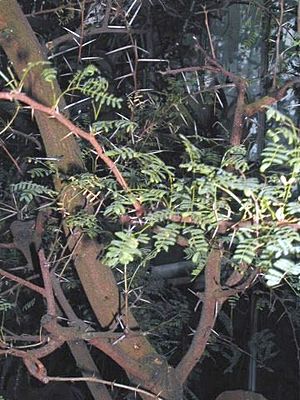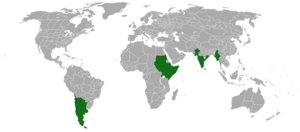Vachellia horrida facts for kids
Quick facts for kids Vachellia horrida |
|
|---|---|
 |
|
| Scientific classification | |
| Kingdom: | |
| (unranked): | |
| (unranked): | |
| (unranked): | |
| Order: | |
| Family: | |
| Genus: |
Vachellia
|
| Species: |
V. horrida
|
| Binomial name | |
| Vachellia horrida (L.) Kyal. & Boatwr.
|
|
| subspecies | |
|
|
 |
|
| Range of Vachellia horrida | |
| Synonyms | |
|
|
Vachellia horrida is a fascinating plant that can grow as a low, spreading shrub or sometimes even a small tree. It is known for its tough, spiny branches. This plant is originally from the warm, tropical and subtropical areas of Southeast Asia. You can find it growing in both wet and dry scrublands.
Contents
What is Vachellia horrida?
Vachellia horrida is a type of plant that belongs to the Fabaceae family. This family is also known as the pea or legume family. Many plants in this group have special pods that hold their seeds. Vachellia horrida is often called a "thorny acacia" because of its sharp spines.
Appearance and Features
This plant is well-known for its strong, sharp thorns. These thorns help protect it from animals that might want to eat its leaves. The plant's leaves are usually small and divided into many tiny leaflets. This gives them a feathery look.
When it blooms, Vachellia horrida produces small, round flowers. These flowers are often bright yellow and grow in clusters. They can make the plant look very pretty. After the flowers, the plant forms seed pods. These pods contain the seeds that will grow into new plants.
How it Grows
Vachellia horrida can adapt to different environments. It can grow in places that are quite dry. It can also grow in areas that get more rain. This makes it a very resilient plant. It often grows in open areas where it can get plenty of sunlight.
Where Vachellia horrida Lives
This plant is native to a large part of Southeast Asia. This region includes countries with warm climates. It thrives in scrublands, which are areas with many shrubs and small trees.
Habitat and Climate
Scrublands can be dry and open, or they can have more moisture. Vachellia horrida is found in both types. It prefers tropical and subtropical climates. These climates have warm temperatures all year round. They also have distinct wet and dry seasons.
The plant's ability to live in different conditions helps it survive. It can handle periods with little water. Its deep roots help it find water underground.
Life Cycle of Vachellia horrida
Like most flowering plants, Vachellia horrida goes through a life cycle. It starts as a seed, grows into a plant, produces flowers, and then makes new seeds.
Reproduction
The flowers of Vachellia horrida are important for reproduction. They attract insects, like bees, that help carry pollen from one flower to another. This process is called pollination. After pollination, the flowers develop into seed pods.
The seeds inside these pods are how the plant creates new generations. When the pods are mature, they open up. The seeds then fall to the ground or are spread by animals. If conditions are right, these seeds will sprout and grow into new Vachellia horrida plants.
Seed Dispersal
Animals often play a role in spreading the seeds. Some animals might eat the pods or seeds. The seeds then pass through their digestive system and are dropped in a new location. This helps the plant spread to different areas.
Importance of Vachellia horrida
Even though it's thorny, Vachellia horrida plays a role in its ecosystem. It provides shelter and food for some animals.
Ecological Role
The dense, thorny branches can offer protection for small birds and other creatures. They can hide from predators among the sharp spines. The flowers provide nectar for insects, which are important pollinators.
In some areas, these plants can help prevent soil erosion. Their root systems hold the soil in place. This is especially helpful in dry or sloped areas.
Images for kids



